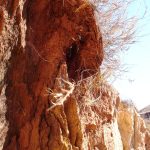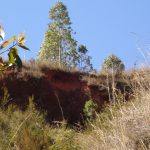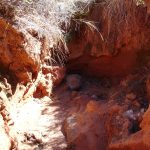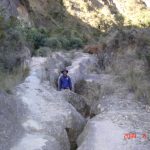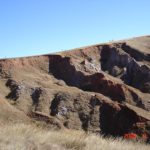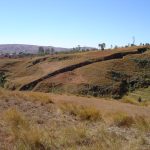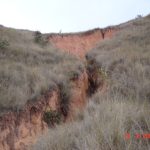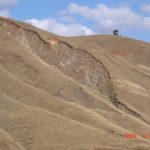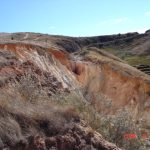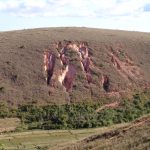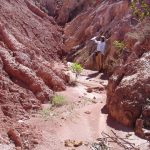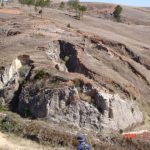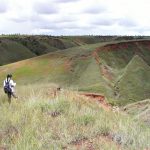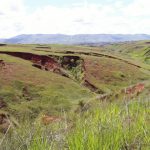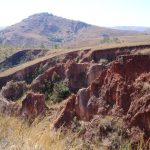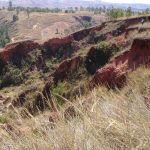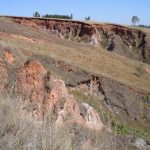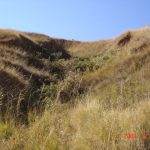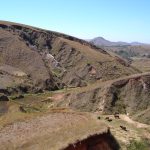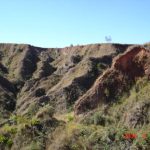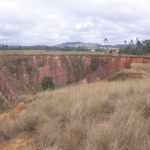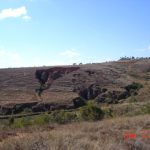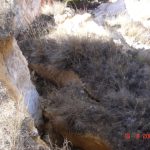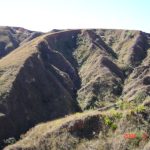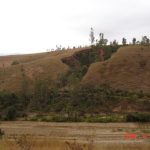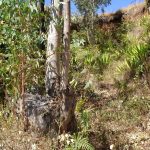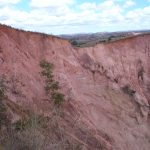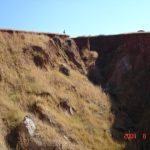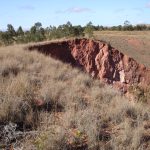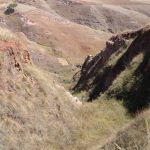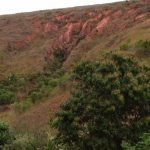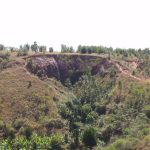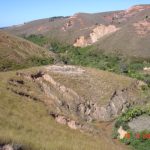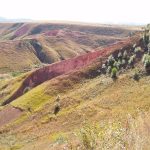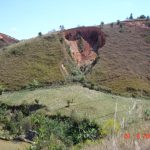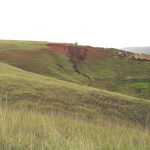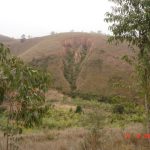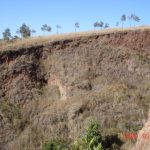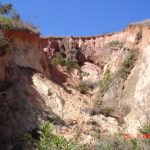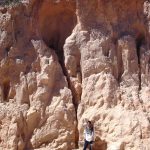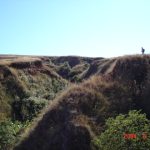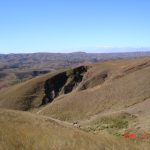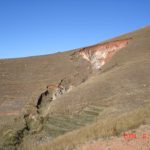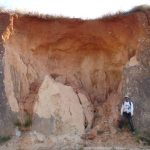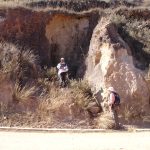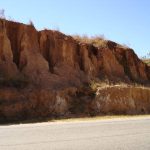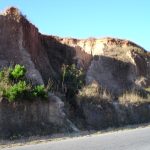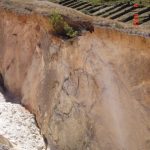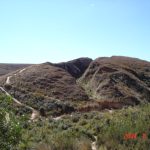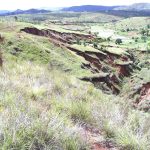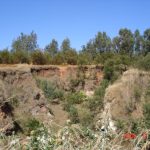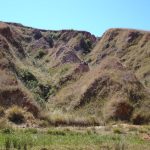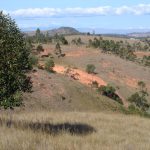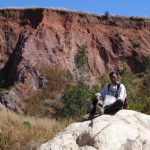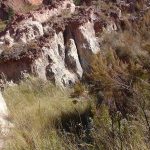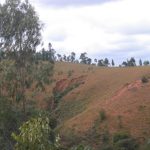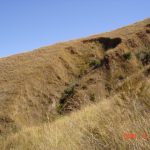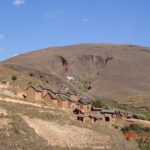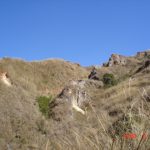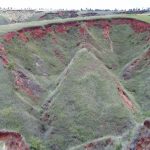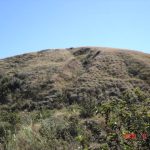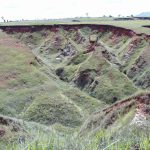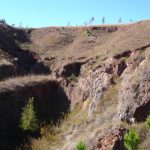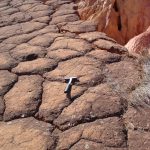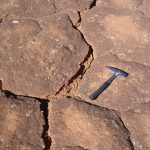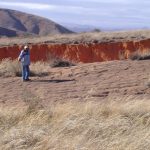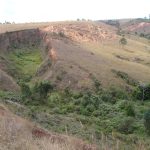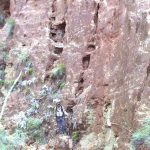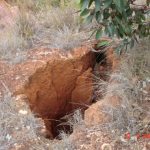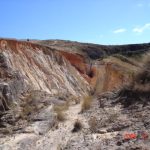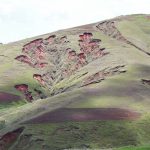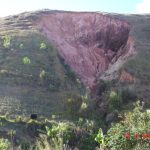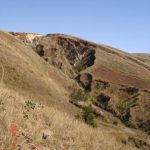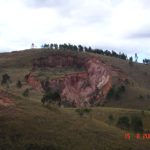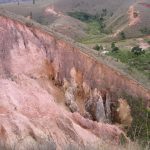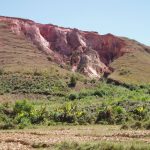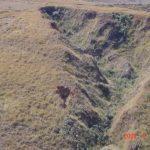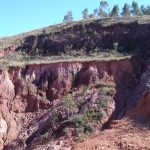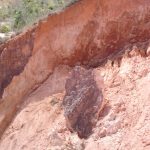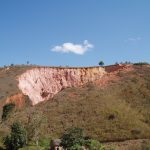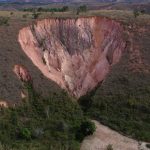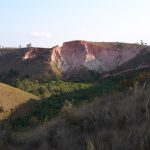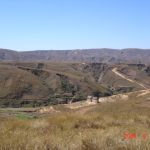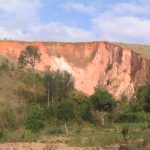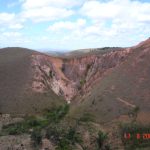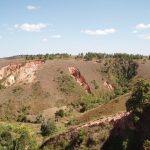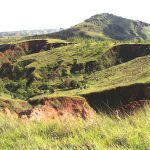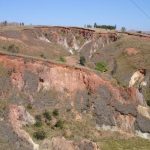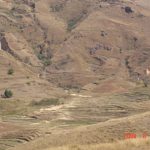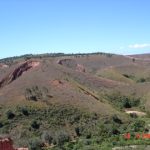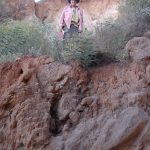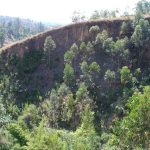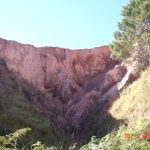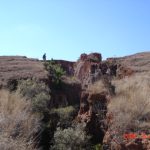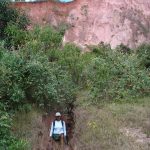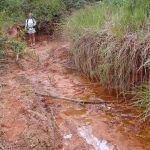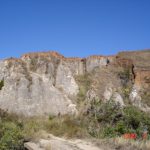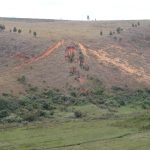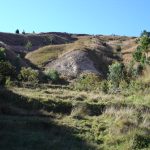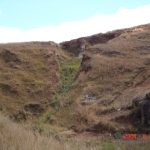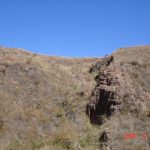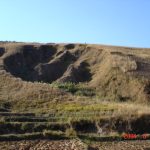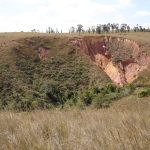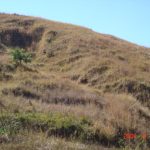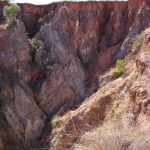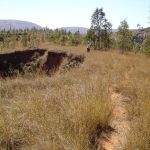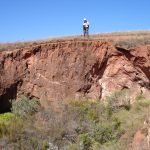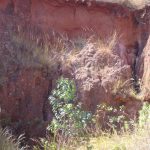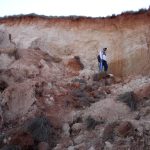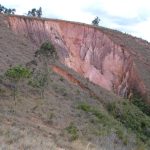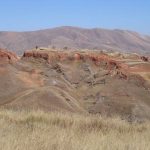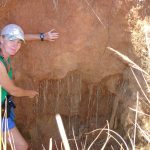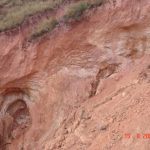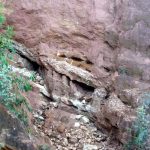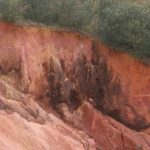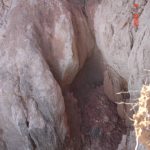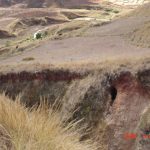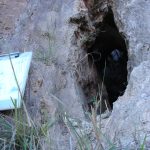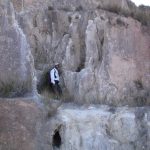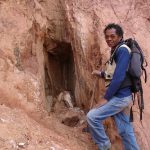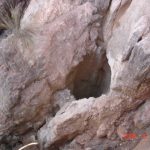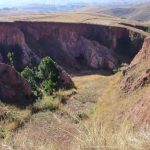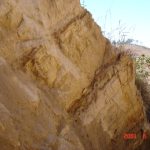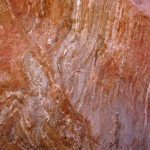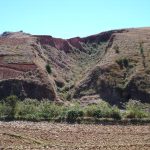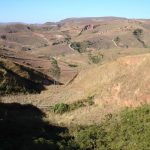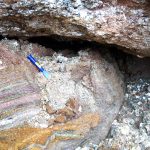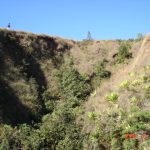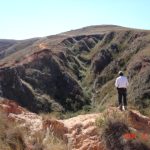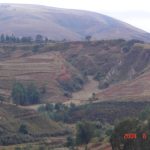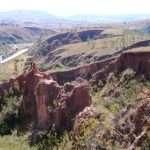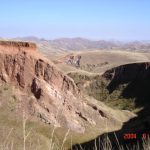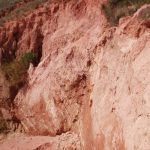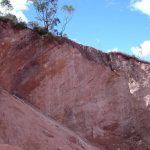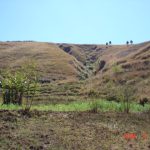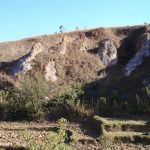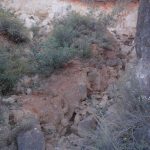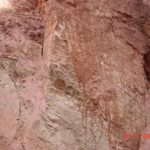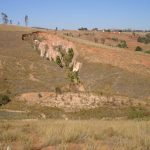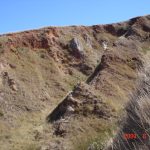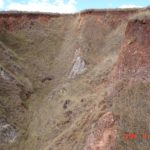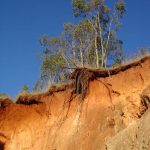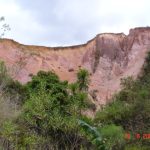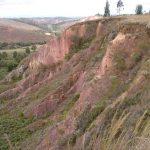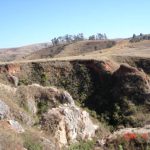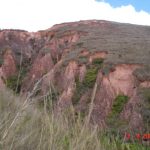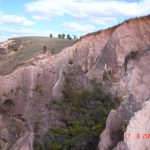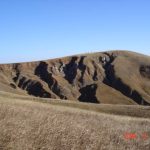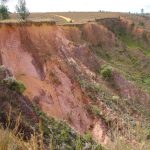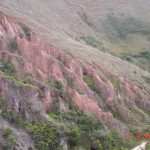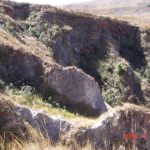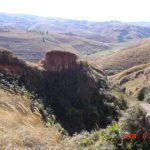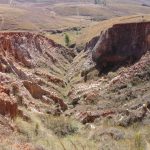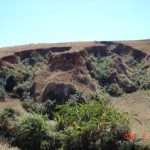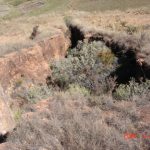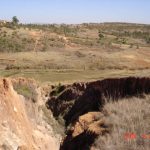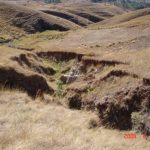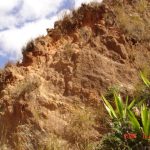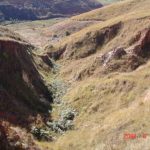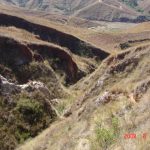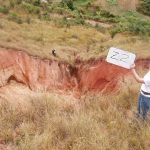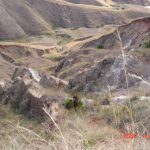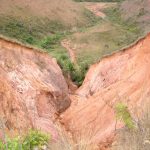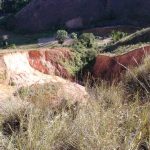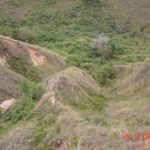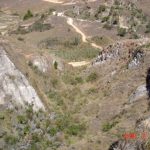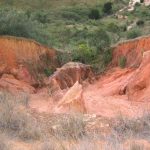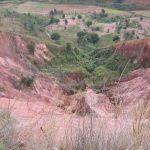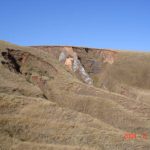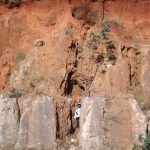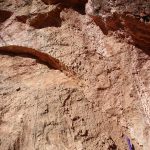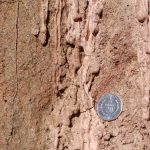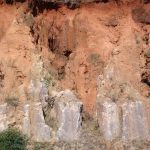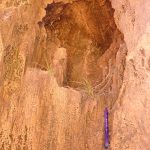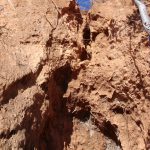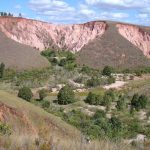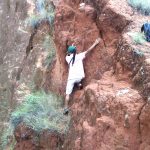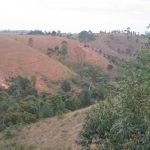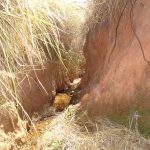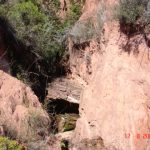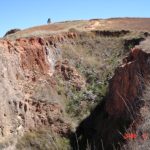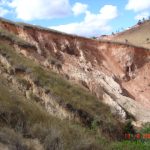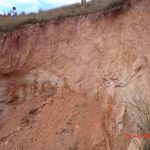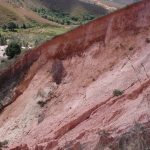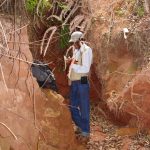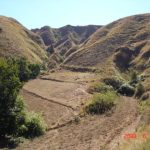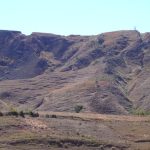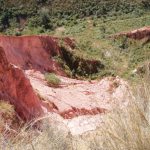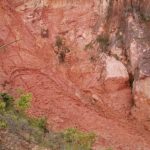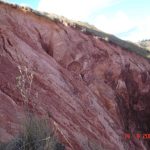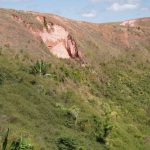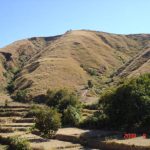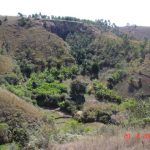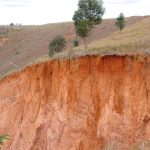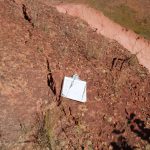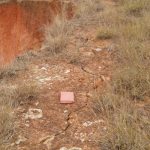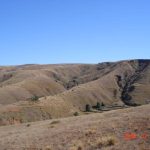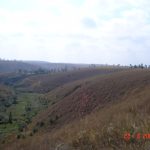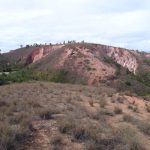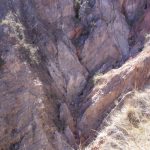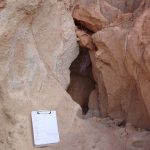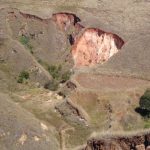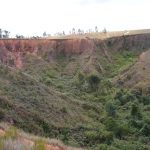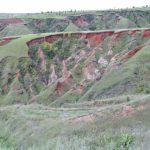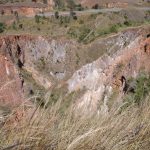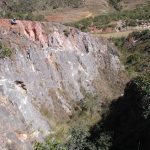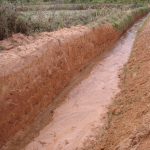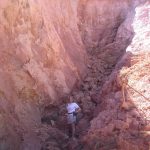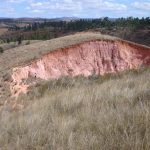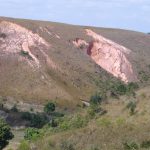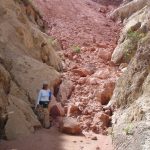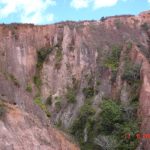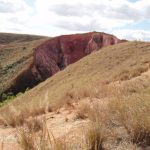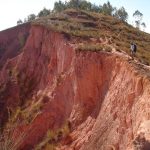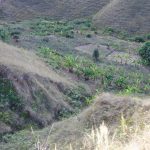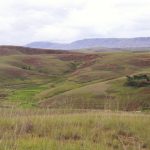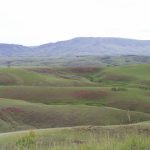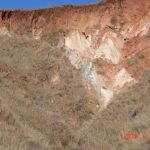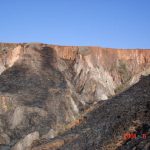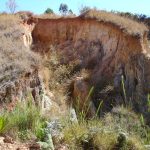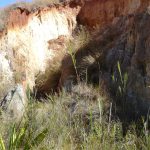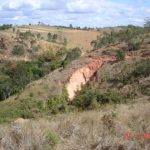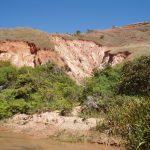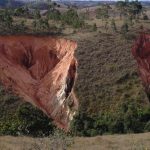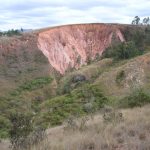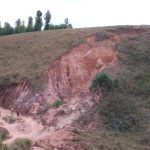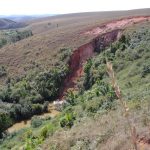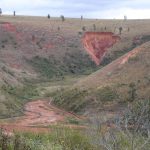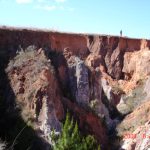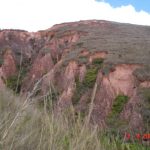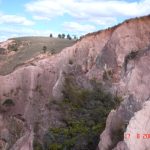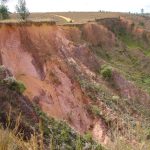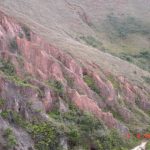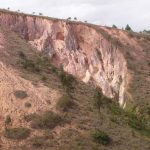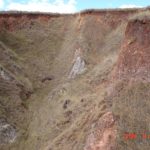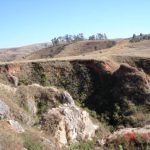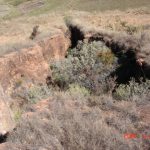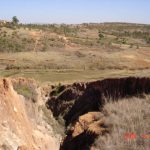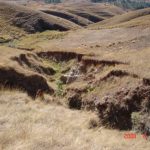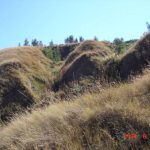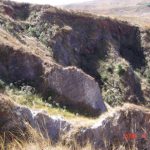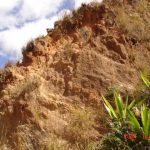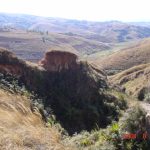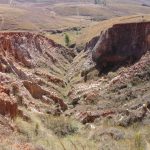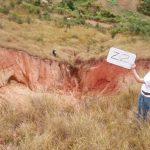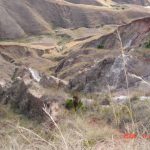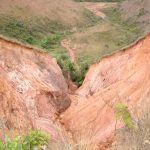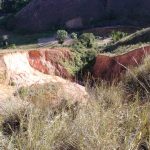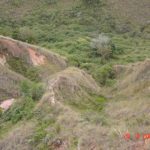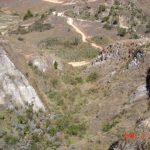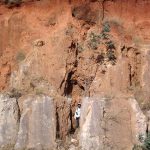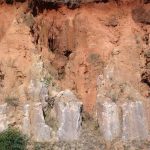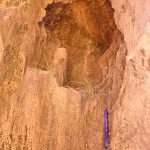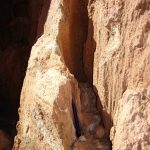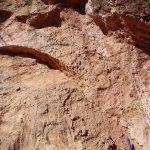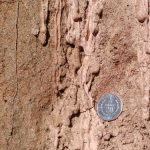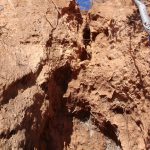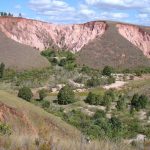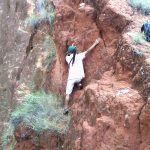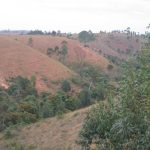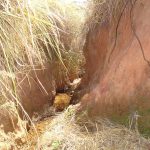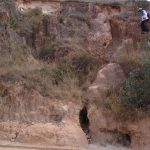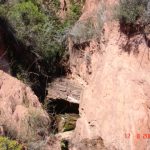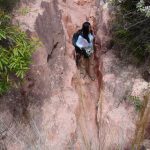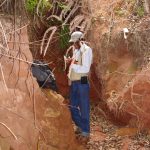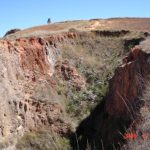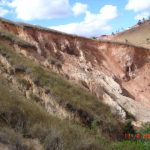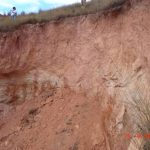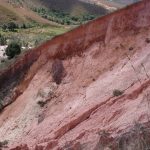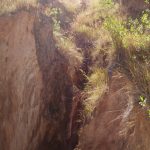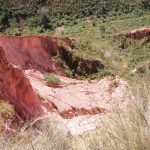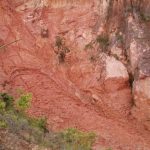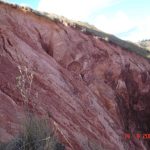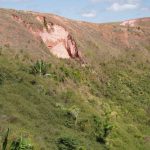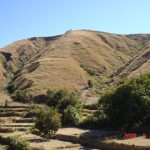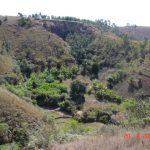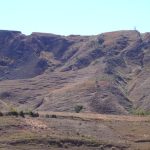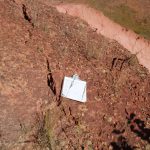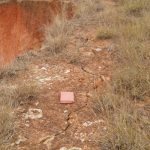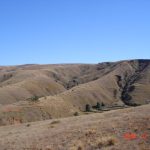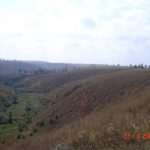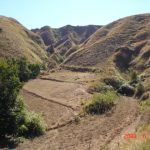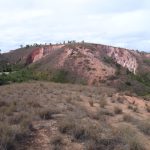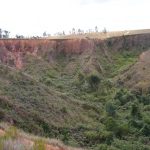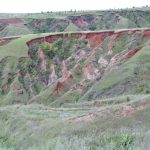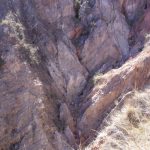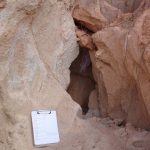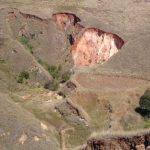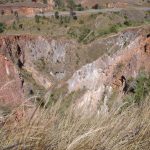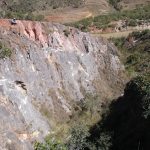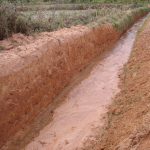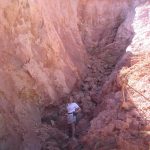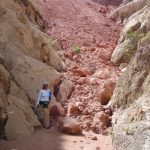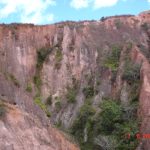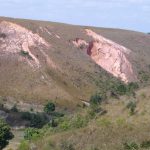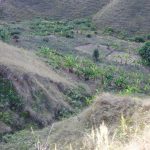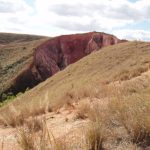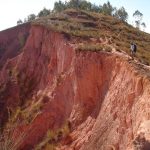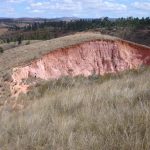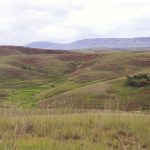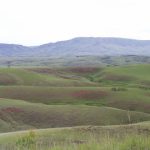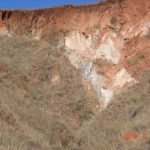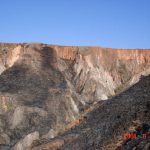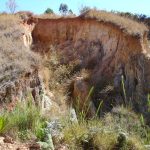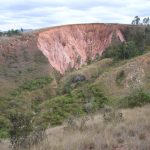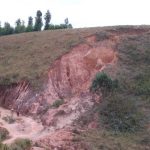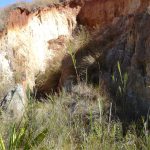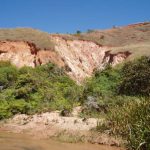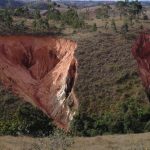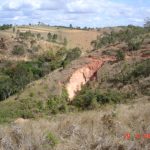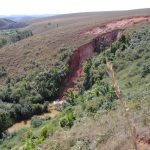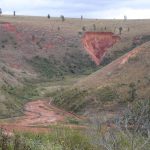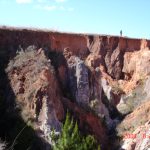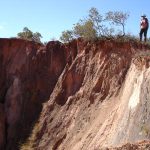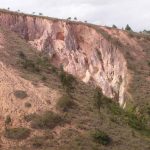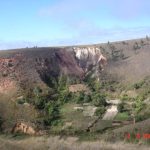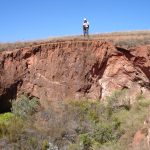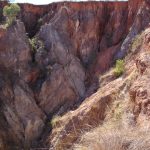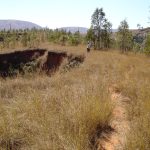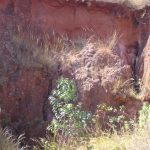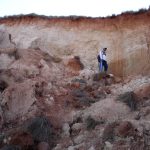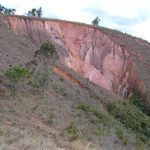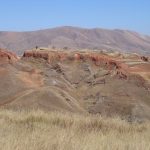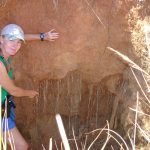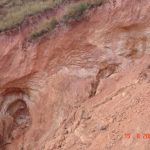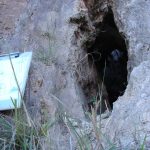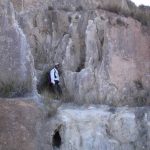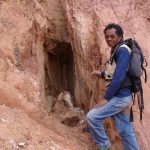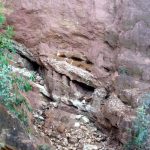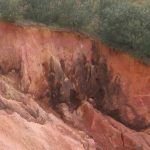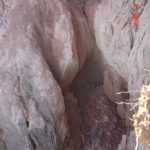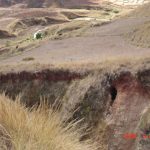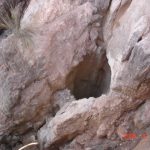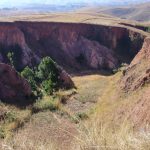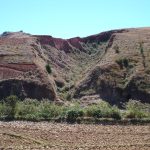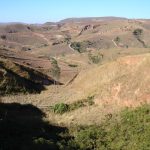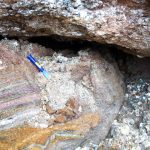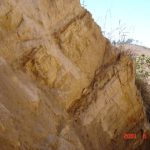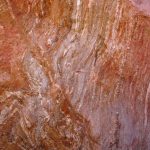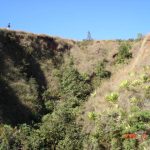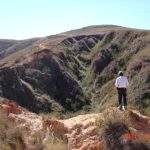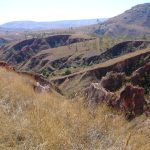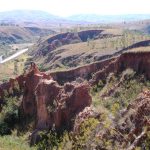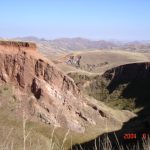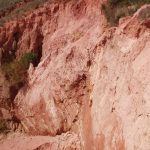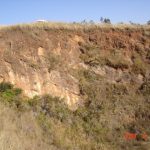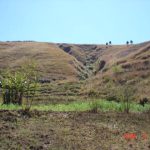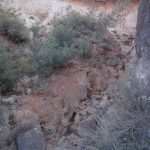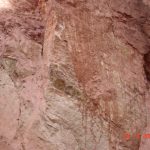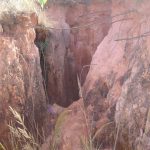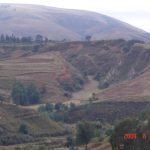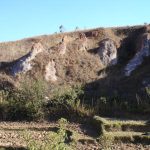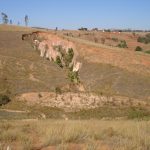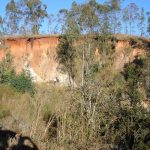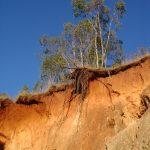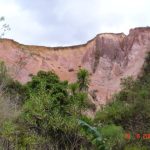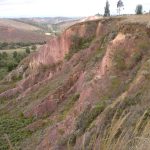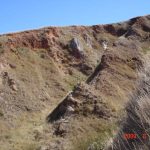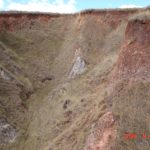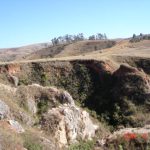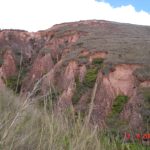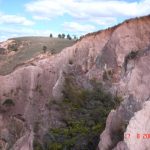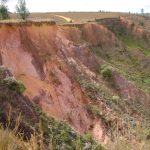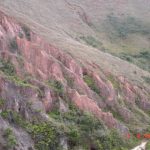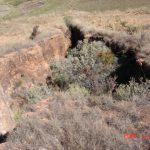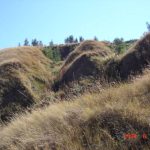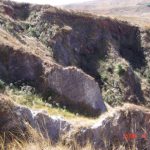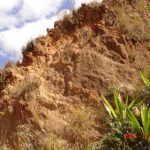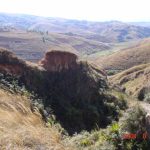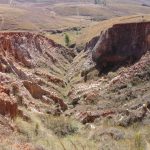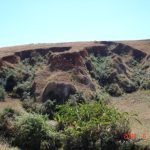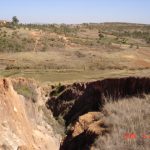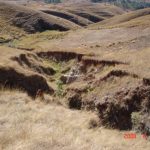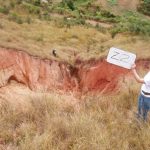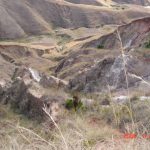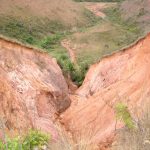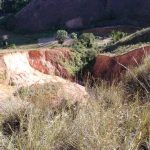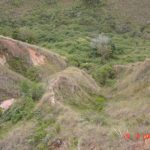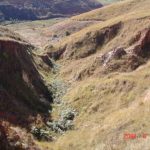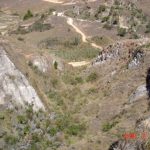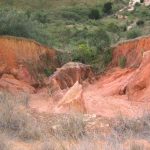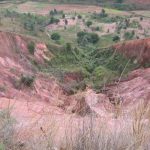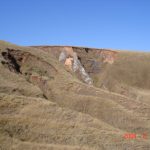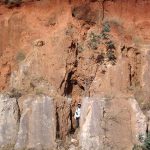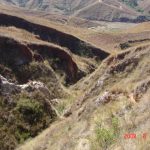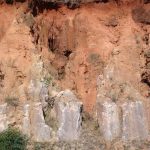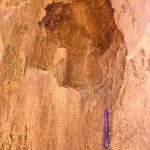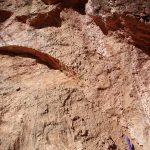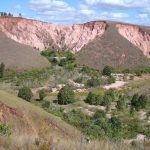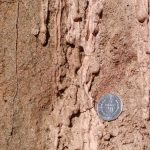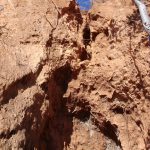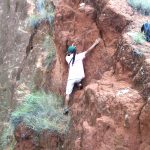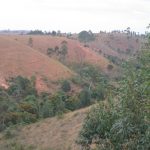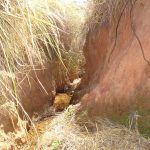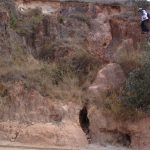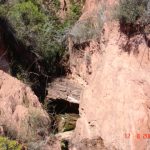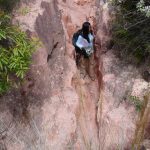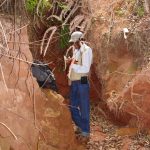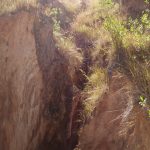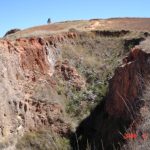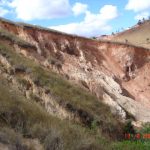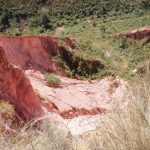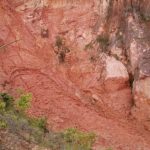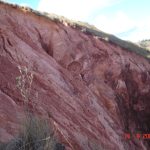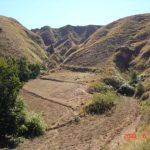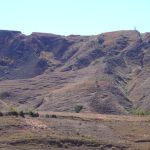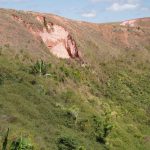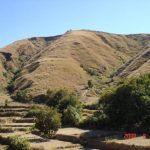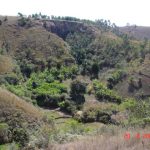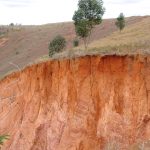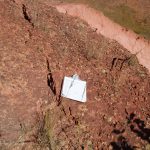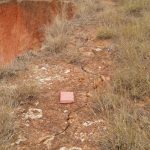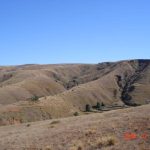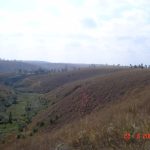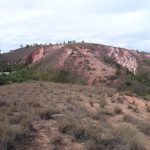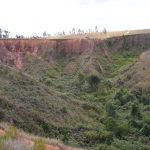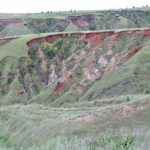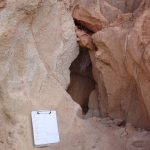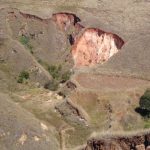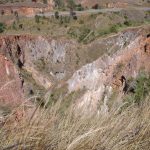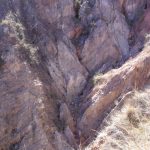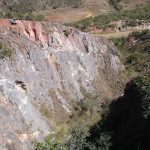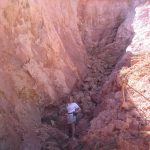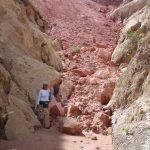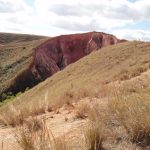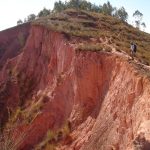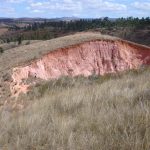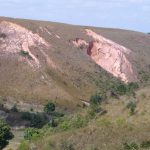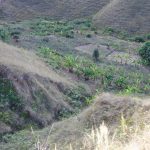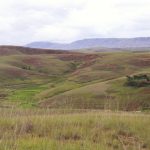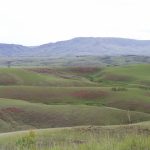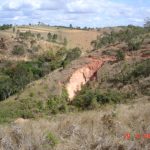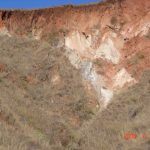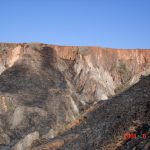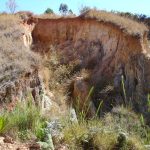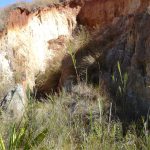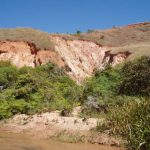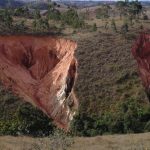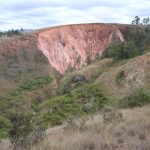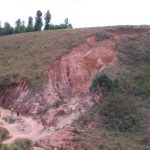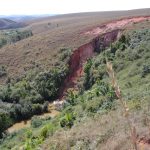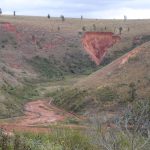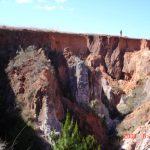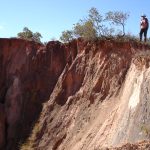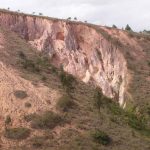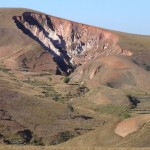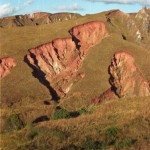- Young lavaka with vertically-dropped
- Young Eucalyptus growing on walls of active lavaka
- Young active lavaka with grottoes in headwall
- Young active lavaka downslope from mature tree stand. No enhanced erosion associated with cattle tracks to right.
- Young active and old inactive lavaka in convex hillslope with rice terraces in foreground
- Within a grotto: vertical cracks
- Within a grotto: vertical cracks
- Within a grotto: vertical cracks
- Within a grotto: vertical cracks
- Weathered/eroded roadcut and old
- Weathering of sidewall
- Weathered vegetated lavaka has cut back to ridge crest.
- Weathered and eroded septae in stage III lavaka
- Weathered and eroded septae in stage III lavaka
- View toward outfall of early stage V lavaka
- View to headwall from vegetated base of barely active lavaka lobe
- View into widened outfall of large stage III lavaka complex
- View from valley into lavaka
- View into cultivated outfall valley from sidewall of stage III lavaka
- View into active stage III lavaka: recent wallfalls form debris apron against headwall in distance
- View from vegetated outfall of recently reactivated lavaka
- View from vegetated outfall of eroded septum and vertical headwall
- View from top of stage V lavaka toward younger lavaka developed in flank
- View from outfall of v-shaped inactive lavaka
- View from outfall of stage V lavaka with newer lavaka developed on right wall
- View from outfall of barely active stage III lavaka
- View from outfall of barely active lavaka
- View from outfall into stage III multi-septate lavaka
- View from outfall into stage III lavaka
- View from headwall of small
- View from headwall of reactivated lavaka showing fresh debris aprons above vegetated lower lavaka and outfall. Across the…
- View from outfall area into stage III multi-septate lavaka
- View from headwall to mouth of lavaka at head of outfall channel (not visible downslope)
- View from headwall onto recently fallen surface. Vegetated surface is horizontal: no rotational component to fall
- View from headwall of partially vegetated outfall with recent sand deposits
- View from headwall of one active large lavaka to active lavaka and bare eroded ground on opposite hillslope. Manioc field in…
- View from headwall of C75 showing large lavaka in mid-ground cutting back through plateau
- View from headwall of active lavaka
- View from headwall of active lavaka
- View from headwall of (unseen) lavaka
- View from head of sporadically active lavaka
- View from cultivated outfall area up into sporadically active stage III lavaka
- View down narrow lavaka
- view across valley from headwall of one lavaka to set of inactive lavakas on far side
- Very long
- Vertical walls
- Vertical walls with cracks and undercutting
- Vertical walls and grottoes in saprolite
- Vertical wall
- Vertical wall
- Vertical wall in saprolite
- Vertical upper walls and debris aprons covering lower walls in active lavaka
- Vertical sidewall
- Vertical sidewall and flat floor in young lavaka
- Vertical upper lavaka wall. Dark colour is wetted laterite; paler material below is dry
- Vertical saprolite walls
- Vertical piping in headwall
- Vertical piping
- Vertical pipes
- Vertical pipes
- Vertical pipes and grottoes in clay-painted wall of largely inactive lavaka
- Vertical pipes and grottoes
- Vertical headwall of active lavaka. Dark patches on saprolite represent seeping groundwater
- Vertical cracks in lavaka sidewall. Planar crack morphology unusual: pipes are more common
- Vertical clay-painted headwall with recent undercutting fall at base.
- Vegetated
- Vegetated outfall of sporadically active lavaka
- Vegetated narrow outfall in foreground
- Vegetated lavaka
- Vegetated interior of mature stage III lavaka
- Vegetated debris apron at lavaka outfall
- Vegetated and weathered lavaka. Eucalyptus are coppiced
- Valley lined with convex hillslopes. Lavakas on left side
- Unvegetated
- Unusual lavaka and gully morphology
- Unusual hook-shaped lavaka
- Undercut saprolite exposed in lavaka sidewall
- Undercut Eucalyptus sapling hanging from headwall
- Two small newer lavakas on wall of old stage V lavaka
- Two small active lavakas and one inactive
- Two lobes. Old lavakas
- Two lobes. Old lavakas
- Two adjacent lavakas
- Two adjacent lavakas coalesced by erosion of the separating hillslope. Smaller lavaka to lower left has long vertical pipe…
- Two active lavakas
- Two active lavakas with dark-stained saprolite indicating groundwater seepage. No recent sand evident in valley
- Two active lavakas separated by an eroding walls
- Two active lavakas separated by an eroding wall
- Two active lavakas below bare ground patch
- Trees colonising active lavaka
- Tree-filled lavaka with bare vertical walls still shedding some sediment
- Toeslope lavakas at edge or rizière
- Toeslope lavakas at edge of rizière
- Systematic plantings (appearing as a stippled pattern on the bare sand deposits of last season) are an attempt to stabilise…
- Steep headwall in mature lavaka
- Steep exposures of laterite and saprolite
- Three conjoined lavakas
- Stage III lavakas
- Stage III lavakas
- Stage III lavaka
- Stage III lavaka
- Stage III lavaka with debris-apron mantled lower walls
- Stage III lavaka retains substantial vertical face in headwall but has little recent sediment in lavaka bottom
- Stage III lavaka has lower sidewalls hidden by vegetated debris aprons
- Stacked sand beds indicate multiple recent sedimentation events from nearby lavaka. Sand beds are variously massive
- Sporadically active lavaka
- Sporadically active lavaka
- Stage III and IV lavakas
- Sporadically active late stage III
- Sporadically active but largely infilled lavaka
- Some remaining vertical head and side wall surfaces in stage III lavaka
- Small-scale lavaka-like erosion in walls of stage V ancient lavaka
- Small-scale lavaka-like erosion in walls of stage V ancient lavaka
- Small-scale activity in sidewall of stage III lavaka
- Small lavaka
- Small lavaka
- Small
- Small two-lobed lavaka
- Small lavaka
- Small inactive lavaka
- Small field on grassy surface in stage III lavaka
- Small active lavaka. Recent sand deposits at lavaka mouth have been planted with bananas
- Small active lavaka with grottoes in back wall and hook-shaped outfall
- Small active lavaka flanked by ancient
- Skyline view of eroding wall between two lavakas
- Sisal plantings on lower slope suggest recent activity from bare walls above path
- Skyline view of eroding wall between two lavakas
- Sisal plantings in base of small wall-falls in stage III lavaka
- Side-septae in partially vegetated lavaka
- Side view of lavaka shows convex hillslope profile
- Showing headwall of lavaka cut back through ridge to next drainage
- Shedding (light) and clay-painted walls in stage III lavaka
- Several erosional forms in hillslope: active lavaka
- Sediment moved along wide flat lavaka floor feeds into narrow incised outfall
- Sediment gravity flow of recent wallfall material over-rides vegetation in recently reactivated lavaka
- Saprolite of varying composition
- Sediment being shed from top of sidewall; lower bare sidewall is clay painted
- Saprolite preserves primary geological structures: pegmatite cross-cutting gneissic foliation
- Saprolite exposures in vertical wall (top and left)
- Roots exposed in sidewall overhang
- Roof fall (vegetated
- Rolling convex slopes in low-lying plain
- Rolling convex slopes in low-lying plain
- Rolling convex slopes in low-lying plain
- Rolling convex slopes in low-lying plain
- Road cut along sidewall of old
- Road along sidewall of mature
- Right side of lavaka shows recent activity; left side is heavily clay-painted and partially vegetated
- Ricefields within stage IV lavaka
- Ricefields in outfall of inactive lavaka
- Rice fields in outfall of stage III lavaka
- Rice and vegetable fields in outfall area of large
- Red laterite above tan and white saprolite in vertical headwall of lightly active stage III lavaka
- Red laterite above pale saprolite in lavaka wall
- Recently reactivated lavaka preserves older
- Recently reactivated lavaka headwall
- Recently reactivated lavaka headwall on right
- Recently reactivated lavaka
- Recent wallfall
- Recent wallfall exposes fresh saprolite and also deposits of older
- Recent wall fall in stage III lavaka
- Recent wall fall forms overhang in active lavaka
- Recent vertical falls indicated by vegetated surfaces within blockfall pile at base of lavaka
- Recent vertical fall from headwall (retaining surface vegetation on upper horizontal surface)
- Recent vertical drop of headwall material (upper flat vegetated surface still preserved)
- Recent small-scale reactivation in headwall of stage III lavaka; note sisal plantings at base (stabilisation attempt)
- Recent sediment movement in sporadically active
- Recent sediment movement and debris apron construction
- Recent substantial wallfall in sporadically active lavaka (walls unvegetated but substantially clay-painted)
- Recent sediment movement (with sediment gravity flow morphology) in active lavaka wall
- Recent sand flow from lavaka just visible in valley
- Recent sand deposits in bottom of reactivated lavaka
- Recent sand deposits from active lavaka carpet the valley bottom
- Recent reactivation of old
- Recent reactivation (stage II-III) of old (stage V) lavaka
- Recent reactivation (stage II) of old lavaka. Sisal plantings in base (attempted stabilisation)
- Recent reactivation (stage II-III) of old (stage V) lavaka
- Recent reactivation (stage II) of old lavaka. Sisal plantings in base (attempted stabilisation)
- Recent reactivation (stage II) of old lavaka. Sisal plantings in base (attempted stabilisation)
- Recent reactivation (pale saprolite exposures) of heavily clay-painted (dark upper walls) stage III lavaka
- Recent fluidised flow and debris flow deposits form debris apron on active lavaka headwall
- Recent fall of lateritic debris (red) mantling outcrops of saprolite (pale)
- Recent blockflow in outfall
- Recent blockfalls in saprolite
- Recent blockfall in small lavaka
- Recent blockfall and grottoes in active lavaka sidewall
- Recent block and sand fall (mostly tan-coloured laterite) contributes to debris apron at base of wall
- Recent activity in stage II lavaka
- Recent activity in stage II lavaka
- Recent activity in stage II lavaka
- Recent activity in reactivated lavaka: mixed blockfall and fluidised flow
- Recent activity in reactivated lavaka
- Recent activity in reactivated lavaka
- Recent activity in lavaka interior
- Reactivation on left side of vegetated
- Reactivation of left side of formerly inactive
- Reactivated lavaka with one remaining clay-painted side wall
- Progressive infilling of lavaka as debris aprons rise higher on slope and lavaka base narrows
- Reactivated headwall shows remnant clay painted surface and wall vegetation
- Poorly developed
- Partial vegetation in stageIII lavakas. Clay painting of bare walls indicates minimal activity in recent rainy season
- Pair of inactive lavakas
- Overhanging laterite and vertical saprolite. Recent wall-fall material has been completely removed: no debris apron at base…
- Overhanging laterite and vertical saprolite
- Overhanging headwall over collapsed lower wall
- Overhanging headwall in young active lavaka
- Overhang at top of vertical head and side walls in stage II lobe]
- Overhanging headwall and exposed Eucalyptus roots in active stage II lavaka
- Overhanging headwall (with seated geologists)
- Overhang at top of vertical head and side walls in stage II lobe]
- Overhang and fractures in active headwall
- Overhang and exposed Eucalyptus roots in recently-active section of stage III complex
- Outfall showing vertical-sided incision
- Outfall picture of non-typical elongate lavaka
- Outfall channel incised in saprolite
- Old lavaka complex on hillslope
- Non-typical elongate lavaka
- Narrow
- No vertical walls remaining in large lavaka
- New lavaka cuts old road
- Nested lavakas of unusual morphology in fall valley wall
- Narrow flat floor of braided flow deposits winds between debris aprons in large active lavaka
- Multiple small lavakas in hillslope
- Multiple lavakas in landscape of convex hills
- Multiple lavakas in landscape of convex hills
- Multiple lavakas in landscape of convex hills
- Multi-septate stage III lavaka complex
- Multi-septate stage III lavaka complex
- Mostly inactive
- Mostly grassed in
- Multi-septate stage III lavaka complex
- Multi-lobed lavaka complex
- Midslope lavaka with deeply incised outfall channel
- Midslope lavaka with deeply incised outfall channel
- Mature
- Mature Eucalyptus trees in mature stage III lavaka
- Mature (coppiced) Eucalyptus growing inside lavaka
- Massive headwall of large lavaka that has cut back through ridge crest.
- Lower walls mantled by debris aprons and limited vertical walls above in mature stage III lavaka
- Low-activity lavaka (all walls clay-painted) with headwall extending back through ridge crest
- Looking from headwall toward outfall of stage III lavaka with vertical upper walls and vegetated
- Long narrow lavaka and bare ground
- Limited activity represented by bare patches at top of headwall in well-vegetated lavaka
- Lavakaed landscape
- Lavakaed landscape
- Lavaka
- Lavaka with long
- Lavaka with eroded septae preserves vertical headwall but has vegetated interior and outfall
- Lavaka sidewall no longer vertical
- Lavaka interior
- Lavaka in roadcut: grotto with overhanging headwall
- Lavaka in partially tree-covered slope. Trees are probably younger than lavaka
- Lavaka in last phases of activity. Small vertical wall sections shed small amounts of sediment
- Lavaka in convex hillslope
- Lavaka high in midslope
- Lavaka formation within a roadcut by vertical subsurface collapse
- lavaka erosion in roadcut
- lavaka erosion in roadcut
- Lavaka developed above and behind weathered/eroded roadcut
- Lavaka cutting old road
- Lavaka cut back through hill crest. New roadcut at outfall
- Lavaka complex above rizière
- Lavaka becoming invaded by pine and eucalyptus scrub
- Lavaka becoming inactive.
- Lavaka and bare ground on sparsely treed slope. Eucalyptus are younger than lavaka
- Laterite and saprolite visible in steep walls of active stage III lavaka
- Laterite and saprolite visible in steep walls of active stage III lavaka
- Largely inactive
- Largely inactive lavakas
- Largely inactive lavakas on hillslope behind village
- Largely inactive lavaka
- Largely inactive lavaka
- Largely inactive lavaka
- Largely inactive lavaka
- Largely inactive lavaka
- Large-scale polygonal cracks in surface beside large active lavaka. Bare ground with large-scale cracks like this is unusual…
- Large-scale polygonal cracks in surface beside large active lavaka. Bare ground with large-scale cracks like this is unusual
- Large-scale polygonal cracks in surface beside large active lavaka. Bare ground with large-scale cracks like this is unusual
- Large
- Large vertical pipe with grottoes and resistant (quartz-rich) layers in saprolite
- Large vertical pipe intersects surface in lavaka headwall
- Large road-cutting lavaka. Old road runs from top right to upper left
- Large plumose lavaka complex. Cows in lower left for scale
- Large midslope lavaka
- Large lavaka with narrow elongate outfall
- Large lavaka with big coherent downdropped block in interior. Very unusual morphology
- Large lavaka surrounded by bare ground erosional patches.
- Large lavaka consists of two adjacent lavakas with intervening wall almost completely removed
- Large inactive lavaka with tiny new lavaka (?3 m long) to left
- Large downdropped block in lavaka interior. May have a small rotational component
- Large block fallen from sidewall
- Large active lavaka
- Large active lavaka
- Large active lavaka
- Large active lavaka
- Landscape with several inactive lavakas
- Large active lavaka with headwall at ridge crest. Recent sand deposits in foreground
- Large active lavaka has cut back through ridge crest. New plantings on exposed sand in outfall area are a stabilisation attempt
- Landscape with lavakas of different sizes and stages of evolution
- Landscape with lavakas of different sizes and stages of evolution
- Landscape with lavakas of different sizes and stages of evolution
- Landscape with lavakas of different sizes and stages of evolution
- Landscape with lavakas at many stages of evolution
- Jane stands on fallen roof (still vegetated in base of newly-formed lavaka
- Jane points to seepage along hairline crack in saprolite
- Interior of tree-filled lavaka
- Interior of steep-walled active lavaka
- Incised outfall from large midslope lavaka
- Incised outfall channel in large lavaka
- Incised narrow outfall channel
- Interior of lightly active stage III lavaka. Retains vertical faces
- Incipient lavaka: collapse is incomplete
- Inactive
- Inactive lavaka. Erosional remnant of gneiss (outcrop lower right) is encased in saprolite
- Inactive lavaka
- Inactive lavaka with eroded diagonal (unusual!) septae
- Inactive lavaka on left (but with central bare patch showing vertical piping)
- Inactive lavaka
- LavakaImages_DC2014_003_136
- LavakaImages_DC2014_003_135
- Headwall of sporadically active lavaka: some recent falls
- LavakaImages_DC2014_003_133
- Headwall of newly-formed lavaka shows red laterite at top
- Head and side walls show both recently collapsed (very pale) and clay-painted (greyish) sections
- LavakaImages_DC2014_003_130
- Groundwater seepage in base of lavaka. Saprolite above (paler) is dry; that below (darker) is wet
- LavakaImages_DC2014_003_128
- Grottoes form in less-resistant (less quartz-rich) saprolite; blocky debris collects at base
- Grottoes and debris aprons in active lavaka
- LavakaImages_DC2014_003_125
- LavakaImages_DC2014_003_124
- Grotto in roadcut
- Grotto in roadcut
- Grotto formed by roof-down blockfall in active sidewall
- LavakaImages_DC2014_003_120
- Grassy floor (with fields) and steep walls of active stage III lavaka
- Gneissic foliation in saprolite exposed in vertical lavaka wall
- LavakaImages_DC2014_003_114
- LavakaImages_DC2014_003_118
- LavakaImages_DC2014_003_117
- Gneissic foliation preserved in multi-coloured saprolite
- Fully v-shaped lavaka with almost no remaining activity
- Fully V-shaped inactive lavaka
- Foreground shows weathered septum within stage III lavaka
- LavakaImages_DC2014_003_104
- Foreground shows weathered septum within stage III lavaka
- LavakaImages_DC2014_003_109
- LavakaImages_DC2014_003_108
- LavakaImages_DC2014_003_107
- LavakaImages_DC2014_003_106
- Fields in outfall area of old lavaka with one remaining sediment-shedding patch (on right)
- Fields in base of weathered and vegetated lavaka
- LavakaImages_DC2014_003_102
- LavakaImages_DC2014_003_101
- LavakaImages_DC2014_003_100
- LavakaImages_DC2014_003_099
- Eroded septum in sporadically active stage III lavaka
- LavakaImages_DC2014_003_093
- Eucalyptus ground in the out fall
- LavakaImages_DC2014_003_097
- Erosion of wall separating two discrete lavakas will generate a large lavaka complex
- LavakaImages_DC2014_003_095
- LavakaImages_DC2014_003_092
- LavakaImages_DC2014_003_091
- LavakaImages_DC2014_003_090
- LavakaImages_DC2014_003_089
- LavakaImages_DC2014_003_088
- Eroded septae in less-active
- Eroded septae in inactive lavaka
- LavakaImages_DC2014_003_085
- LavakaImages_DC2014_003_083
- Early stage III lavaka
- LavakaImages_DC2014_003_081
- Down-valley view of long outfall channel
- LavakaImages_DC2014_003_079
- LavakaImages_DC2014_003_078
- Eroded laterite overlying paler saprolite (foliation visible dipping to right)
- LavakaImages_DC2014_003_072
- Down-lavaka view of barely active stage III lavaka
- Down-lavaka view showing narrow winding outfall
- Down-lavaka view showing eroded septae and long outfall channel to valley floor
- LavakaImages_DC2014_003_075
- LavakaImages_DC2014_003_074
- LavakaImages_DC2014_003_073
- LavakaImages_DC2014_003_070
- LavakaImages_DC2014_003_069
- LavakaImages_DC2014_003_068
- LavakaImages_DC2014_003_067
- Development of lavaka erosion above and behind roadcut in laterite/saprolite
- LavakaImages_DC2014_003_062
- LavakaImages_DC2014_003_061
- Development of lavaka erosion above and behind roadcut in laterite/saprolite
- LavakaImages_DC2014_003_064
- LavakaImages_DC2014_003_063
- Detail of lavaka erosion in roadcut (1): grotto formed below crack from surface
- LavakaImages_DC2014_003_059
- LavakaImages_DC2014_003_058
- LavakaImages_DC2014_003_057
- LavakaImages_DC2014_003_056
- LavakaImages_DC2014_003_055
- LavakaImages_DC2014_003_054
- LavakaImages_DC2014_003_053
- LavakaImages_DC2014_003_051
- Declining activity in mature lavaka. Bare vertical faces remain
- Debris aprons
- Debris apron of recently fallen wall material
- Debris apron in large active lavaka
- LavakaImages_DC2014_003_052
- LavakaImages_DC2014_003_040
- Crestline with bites out of it: lavakas cut through ridgeline
- LavakaImages_DC2014_003_046
- LavakaImages_DC2014_003_045
- LavakaImages_DC2014_003_044
- LavakaImages_DC2014_003_043
- LavakaImages_DC2014_003_042
- LavakaImages_DC2014_003_041
- LavakaImages_DC2014_003_038
- LavakaImages_DC2014_003_037
- LavakaImages_DC2014_003_036
- LavakaImages_DC2014_003_035
- Convex hills and flat valley floor. One lavaka partly hidden on right side
- LavakaImages_DC2014_003_033
- LavakaImages_DC2014_003_030
- LavakaImages_DC2014_003_029
- LavakaImages_DC2014_003_028
- Complex of three lavakas. The rightmost lobe is essentially inactive
- LavakaImages_DC2014_003_031
- Clay-painted walls in stage III lavaka
- LavakaImages_DC2014_003_026
- Canal dug to divert (away from ricefields) sediment flows coming from active lavaka
- LavakaImages_DC2014_003_024
- LavakaImages_DC2014_003_019
- Bare ground patches and lavaka on hillslope. The bare ground patches appear in 1965 air photos
- LavakaImages_DC2014_003_023
- LavakaImages_DC2014_003_022
- LavakaImages_DC2014_003_021
- LavakaImages_DC2014_003_020
- LavakaImages_DC2014_003_017
- LavakaImages_DC2014_003_016
- LavakaImages_DC2014_003_015
- Amphitheatre view of active lavaka
- LavakaImages_DC2014_003_013
- LavakaImages_DC2014_003_012
- Active stage II lobe in stage III complex
- Active lavaka
- Active lavaka with recent debris flow entering stream in foreground
- Active lavakas. Both appear on 1965 air photos
- LavakaImages_DC2014_003_007
- Active lavaka intersecting road
- LavakaImages_DC2014_003_005
- LavakaImages_DC2014_003_004
- LavakaImages_DC2014_003_003
- LavakaImages_DC2014_003_002
- LavakaImages_DC2014_003_091
- Eroded septae in recently reactivated lavaka
- Eroded septae in old lavaka complex
- LavakaImages_DC2014_003_088
- LavakaImages_DC2014_003_087
- LavakaImages_DC2014_003_001
- LavakaImages_DC2014_003_093
- LavakaImages_DC2014_003_092
- LavakaImages_DC2014_003_080
- LavakaImages_DC2014_003_079
- Down-valley view of long outfall channel
- LavakaImages_DC2014_003_086
- LavakaImages_DC2014_003_085
- LavakaImages_DC2014_003_084
- Early stages of erosion in median septum of stage III lavaka
- LavakaImages_DC2014_003_082
- LavakaImages_DC2014_003_081
- LavakaImages_DC2014_003_077
- LavakaImages_DC2014_003_076
- Down-lavaka view showing channelised sediments in outfall
- Down-lavaka view of recent activity in stage III lavaka
- LavakaImages_DC2014_003_073
- LavakaImages_DC2014_003_072
- LavakaImages_DC2014_003_071
- Down-lavaka view of barely active stage III lavaka
- LavakaImages_DC2014_003_067
- LavakaImages_DC2014_003_066
- LavakaImages_DC2014_003_065
- Detail of lavaka erosion in roadcut (5): small grotto developed below hairline fracture (connected to surface)
- LavakaImages_DC2014_003_063
- LavakaImages_DC2014_003_062
- LavakaImages_DC2014_003_061
- LavakaImages_DC2014_003_060
- LavakaImages_DC2014_003_059
- LavakaImages_DC2014_003_058
- LavakaImages_DC2014_003_057
- LavakaImages_DC2014_003_056
- Deeply incised
- LavakaImages_DC2014_003_054
- Deeply incised
- Deeply incised
- LavakaImages_DC2014_003_050
- LavakaImages_DC2014_003_049
- LavakaImages_DC2014_003_048
- LavakaImages_DC2014_003_047
- LavakaImages_DC2014_003_051
- Debris apron against active lavaka sidewall represents small-scale reactivation of otherwise fully vegetated lavaka
- Debris apron against active lavaka headwall
- LavakaImages_DC2014_003_044
- LavakaImages_DC2014_003_043
- Cultivation in outfall areas of vegetated
- Cultivation in outfall area of vegetated
- LavakaImages_DC2014_003_039
- LavakaImages_DC2014_003_038
- LavakaImages_DC2014_003_037
- LavakaImages_DC2014_003_036
- Convex topography and inactive lavakas
- LavakaImages_DC2014_003_034
- Cultivated outfall area of mature
- Convex hill with lavakas on two sides and bare ground on the near slope
- LavakaImages_DC2014_003_032
- Complex of coalesced lavakas
- LavakaImages_DC2014_003_030
- LavakaImages_DC2014_003_029
- Closeup of active lobe in previous picture.
- LavakaImages_DC2014_003_027
- Clay-painted wall with few recently-eroded spots
- LavakaImages_DC2014_003_025
- Blockflow or lag deposit in active lavaka. Foliation in exposed saprolite visible in headwall; debris aprons in foreground
- Blockflow in narrow throat of large active lavaka
- Big vertical wall showing piping
- LavakaImages_DC2014_003_018
- Bananas and fields in outfall area of largely inactive
- LavakaImages_DC2014_003_021
- LavakaImages_DC2014_003_020
- LavakaImages_DC2014_003_019
- Ancient lavakas
- LavakaImages_DC2014_003_015
- LavakaImages_DC2014_003_014
- LavakaImages_DC2014_003_013
- LavakaImages_DC2014_003_012
- Active lavaka with recently moved sand visible in floor of narrow twisting outfall. Erosional remnant of bedrock exposed near he
- LavakaImages_DC2014_003_006
- LavakaImages_DC2014_003_011
- LavakaImages_DC2014_003_010
- LavakaImages_DC2014_003_009
- LavakaImages_DC2014_003_008
- LavakaImages_DC2014_003_005
- LavakaImages_DC2014_003_004
- Active headwall with recent debris and blockfall deposits
- LavakaImages_DC2014_003_002
- [missing]
- LavakaImages_DC2014_003_137
- LavakaImages_DC2014_003_134
- Headward erosion of headwall
- Headwall of stage III lavaka cuts back through ridge crest
- Headwall of sporadically active lavaka
- LavakaImages_DC2014_003_132
- LavakaImages_DC2014_003_131
- Hadivory: ancient defensive village site. Surrounding ditches have become heavily eroded.
- LavakaImages_DC2014_003_129
- Grottoes in saprolite at base of active wall
- LavakaImages_DC2014_003_123
- LavakaImages_DC2014_003_122
- LavakaImages_DC2014_003_121
- LavakaImages_DC2014_003_127
- LavakaImages_DC2014_003_126
- Grotto with sediment at base of pipe in lavaka wall
- Grotto in sidewall debris apron of large lavaka
- Grotto at base of vertical crack in lavaka wall
- LavakaImages_DC2014_003_119
- Grassed-in lavaka with few vertical active sections remaining
- Grassed
- LavakaImages_DC2014_003_116
- LavakaImages_DC2014_003_115
- Gneissic foliation in saprolite exposed in vertical lavaka wall
- LavakaImages_DC2014_003_113
- LavakaImages_DC2014_003_112
- LavakaImages_DC2014_003_111
- LavakaImages_DC2014_003_110
- Foliation visible in saprolite projecting into lavaka (septum)
- Foliation preserved in saprolite in wall of active lavaka
- Foliation preserved in saprolite in vertical wall of active lavaka
- Foliation in saprolite
- LavakaImages_DC2014_003_105
- Fallen roof (flat
- Exposed saprolite
- Exposed roots extend across top of newly formed small lavaka
- Fields in flat floor of large lavaka complex
- LavakaImages_DC2014_003_103
- Eucalyptus saplings being planted in recent sandflow from active lavaka (stabilisation attempt)
- LavakaImages_DC2014_003_098
- Eucalyptus ground in the headwall
- LavakaImages_DC2014_003_096
- Eroded stumps of multiple septae in vegetated
- LavakaImages_DC2014_003_094
- Eroded septum in sporadically active stage III lavaka
- Eroded septate in lightly active stage III lavaka
- Eroded septae in side wall of lavaka
- LavakaImages_DC2014_003_090
- LavakaImages_DC2014_003_089
- Eroded septae in old lavaka complex
- LavakaImages_DC2014_003_087
- LavakaImages_DC2014_003_080
- LavakaImages_DC2014_003_086
- Eroded radial septae in stage III lavaka
- LavakaImages_DC2014_003_084
- LavakaImages_DC2014_003_083
- LavakaImages_DC2014_003_082
- Dual-lavaka complex
- Down-valley view of long outfall channel
- LavakaImages_DC2014_003_078
- LavakaImages_DC2014_003_077
- LavakaImages_DC2014_003_076
- LavakaImages_DC2014_003_075
- LavakaImages_DC2014_003_074
- Down-lavaka view of largely inactive lavaka
- Down-lavaka view of largely inactive lavaka
- LavakaImages_DC2014_003_070
- LavakaImages_DC2014_003_069
- Down-lavaka view of active lavaka with vegetated bottom and outfall. Recent sand deposits on valley floor. Fields there have…
- Different activity levels in lavakas on hillslope
- LavakaImages_DC2014_003_066
- LavakaImages_DC2014_003_071
- LavakaImages_DC2014_003_065
- LavakaImages_DC2014_003_064
- Detail of lavaka erosion in roadcut (4): erosion within fissure in saprolite
- Detail of lavaka erosion in roadcut (3): dripstone clay painting by elutriated fines
- Despite their fresh
- Detail of lavaka erosion in roadcut (2): dripstone clay painting by elutriated fines
- LavakaImages_DC2014_003_060
- Descent into lavaka
- “Demi-orange” topography
- Deeply incised
- LavakaImages_DC2014_003_055
- Deeply incised
- LavakaImages_DC2014_003_053
- LavakaImages_DC2014_003_052
- Deeply incised
- LavakaImages_DC2014_003_050
- LavakaImages_DC2014_003_049
- LavakaImages_DC2014_003_048
- LavakaImages_DC2014_003_047
- LavakaImages_DC2014_003_046
- LavakaImages_DC2014_003_045
- Debris apron (foreground) and saprolite with foliation (background)
- LavakaImages_DC2014_003_040
- LavakaImages_DC2014_003_039
- Dark patches in pale saprolite represent water seepage in active lavaka wall
- LavakaImages_DC2014_003_042
- LavakaImages_DC2014_003_041
- Cracks and vertical pipes in side and headwall of active lavaka.
- Crack behind active headwall: probable site of next season’s wallfall
- Crack behind active headwall: probable site of next season’s wallfall
- LavakaImages_DC2014_003_035
- LavakaImages_DC2014_003_034
- LavakaImages_DC2014_003_033
- LavakaImages_DC2014_003_032
- LavakaImages_DC2014_003_031
- Closeup of enclosed grotto in wall of active lavaka
- LavakaImages_DC2014_003_028
- LavakaImages_DC2014_003_027
- Closeup of erosion in saprolite at base of headward-eroding lavaka
- LavakaImages_DC2014_003_026
- LavakaImages_DC2014_003_025
- LavakaImages_DC2014_003_024
- LavakaImages_DC2014_003_023
- LavakaImages_DC2014_003_022
- Big lavaka
- Big lavaka cuts back through ridge crest. Headwall was already in this position in 1965 air photos
- Big lavaka cuts back through ridge crest. Headwall was already in this position in 1965 air photos
- LavakaImages_DC2014_003_018
- LavakaImages_DC2014_003_017
- LavakaImages_DC2014_003_016
- Ancient lavakas
- LavakaImages_DC2014_003_008
- LavakaImages_DC2014_003_014
- Active vertical faces in early stage III lavaka. Blackened surfaces are burnt grasses
- Active stage II lobe in stage III complex
- LavakaImages_DC2014_003_011
- LavakaImages_DC2014_003_010
- LavakaImages_DC2014_003_009
- LavakaImages_DC2014_003_007
- LavakaImages_DC2014_003_006
- Active lavaka in meander bend of river
- Active lavaka in head of ancient equilibrated lavaka (note convex slopes of old lavaka walls)
- LavakaImages_DC2014_003_003
- Active head- and sidewall erosion
- 5m Eucalyptus growing on older debris pile on left
- DSC_0653
- DSC_0652

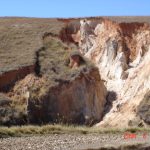
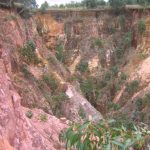
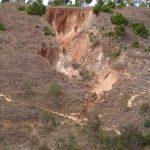
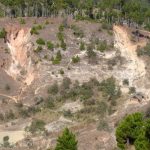
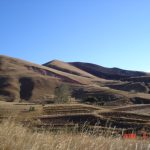
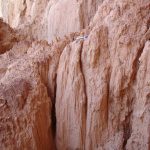
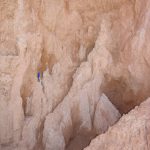
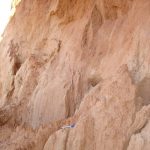
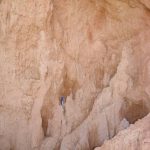
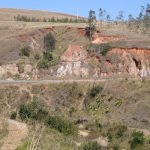
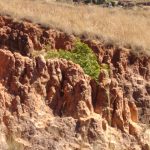
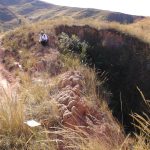
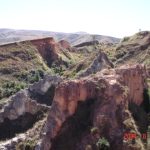
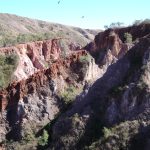
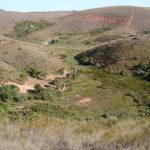
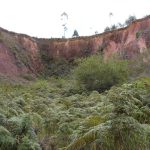
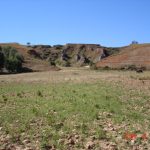

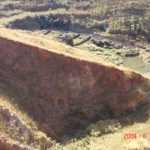
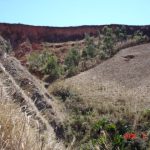
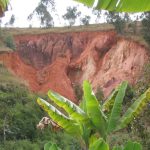
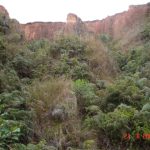
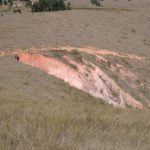
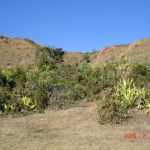
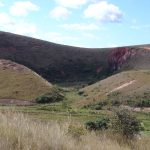
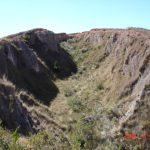
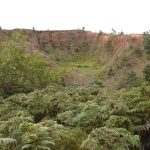
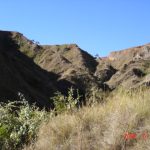
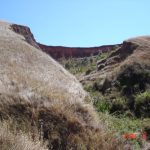
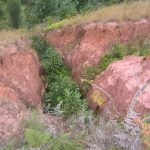
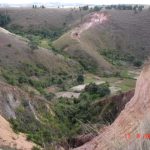
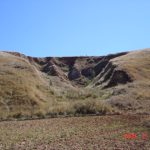
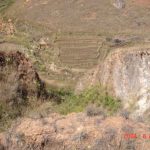
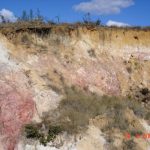
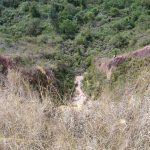
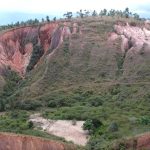

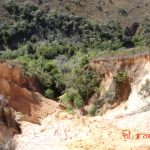
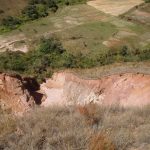
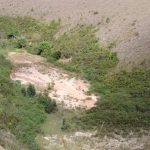
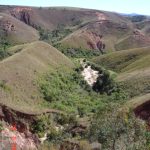
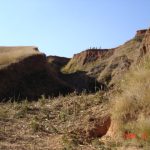
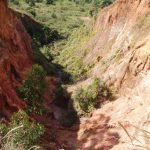
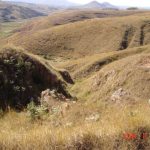
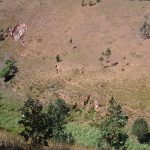
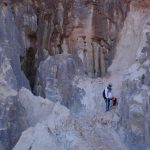
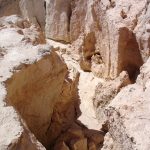
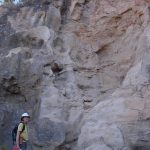
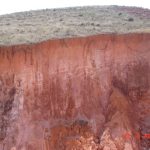
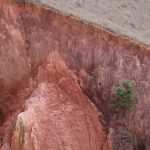
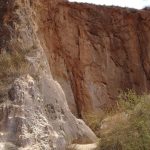
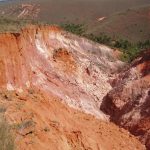
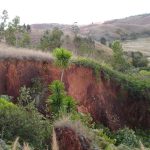
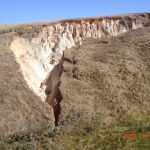
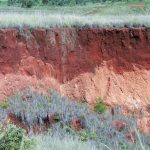
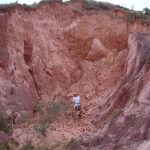
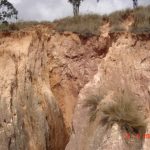
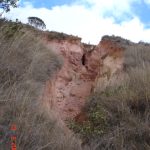
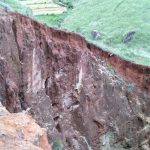

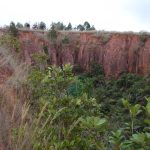
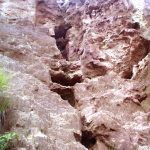

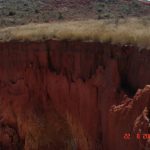
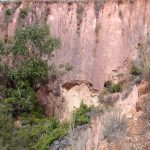
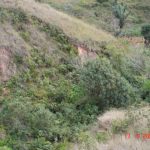
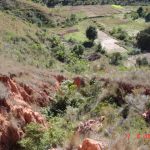
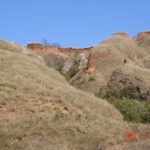
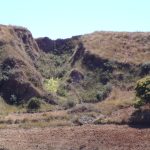
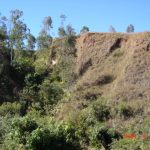
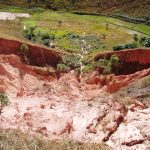
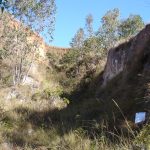
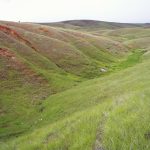

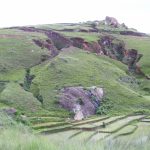
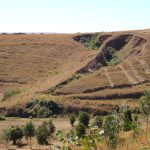
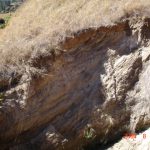
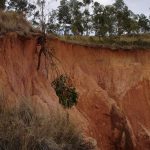
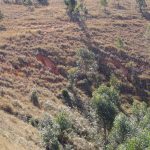
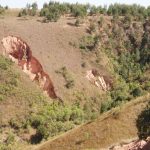
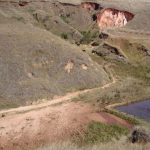
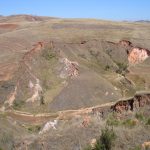
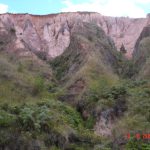
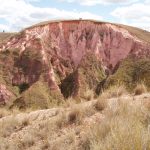
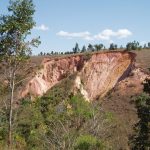
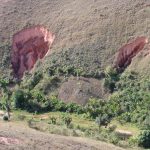
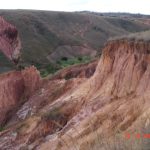
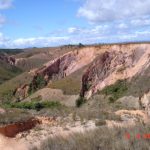
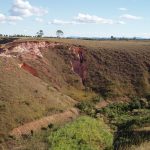

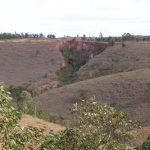
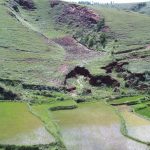
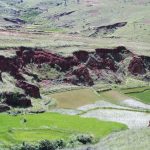
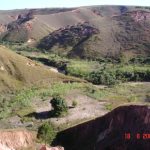
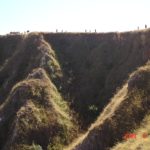
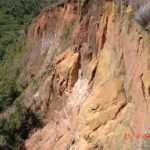
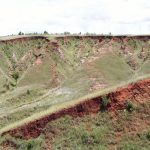
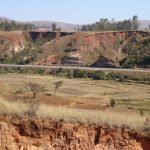
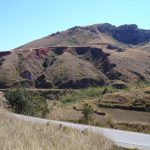
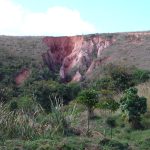
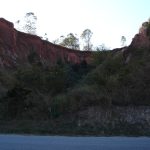

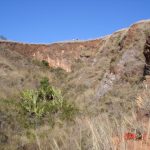
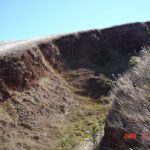
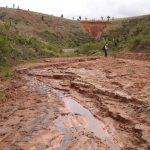
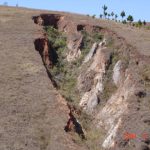

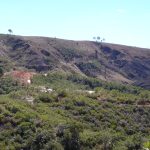
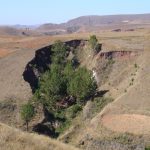
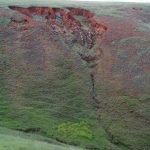
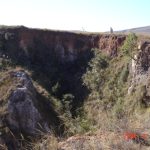
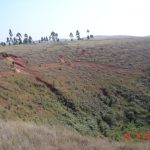
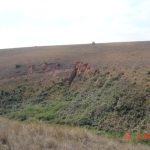
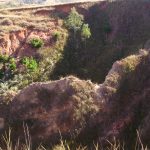
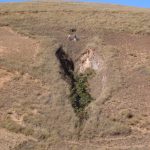
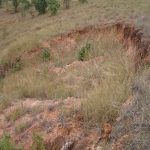
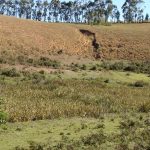
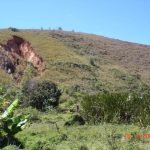
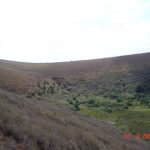
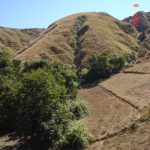
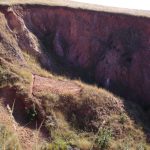
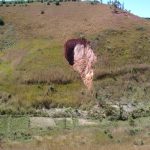
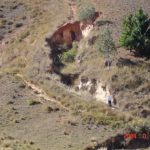
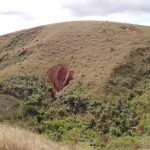
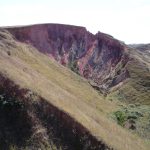
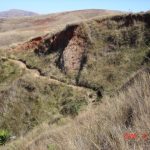
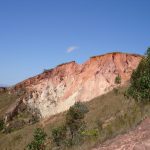
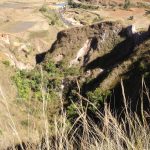
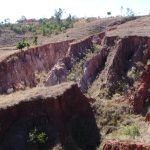
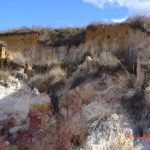
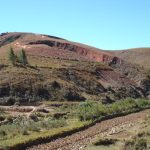
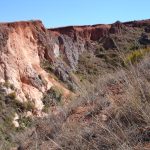
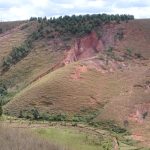
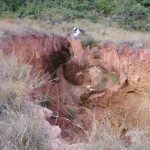
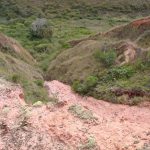
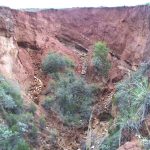
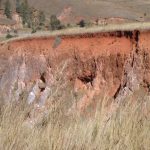
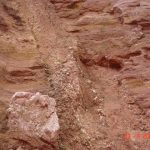
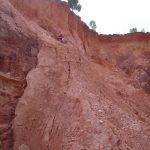
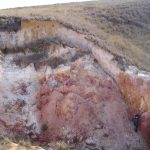
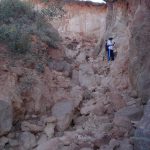
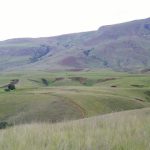
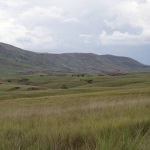
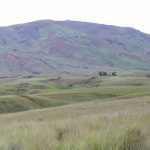
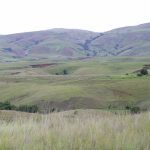
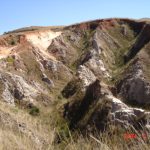
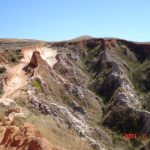
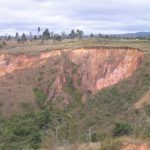
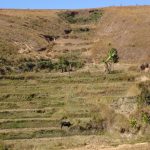
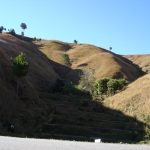
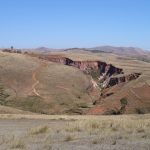
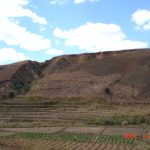
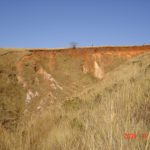
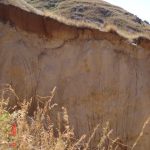
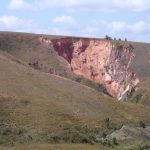
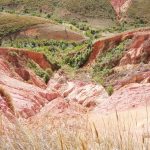
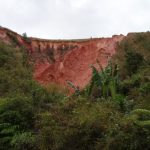

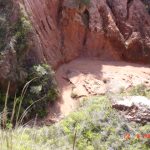
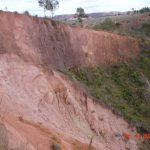
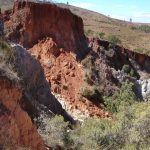
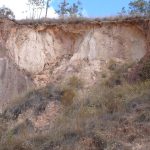
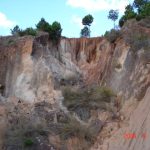
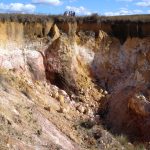
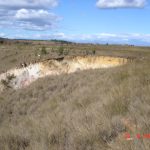
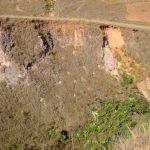
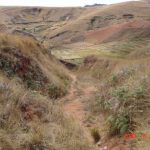
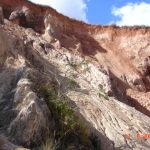
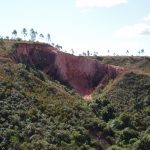
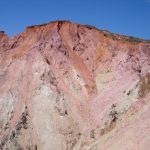
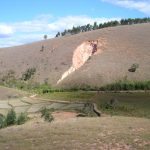
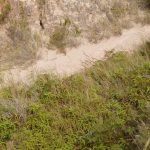
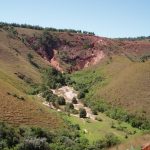

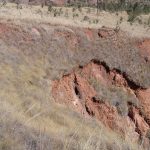
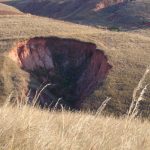
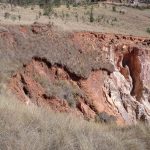
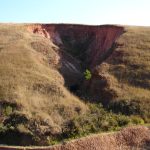
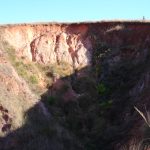
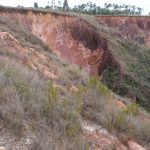
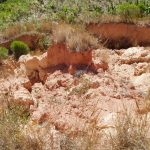
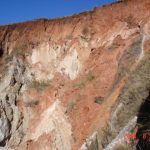
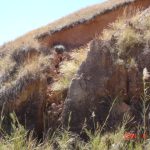
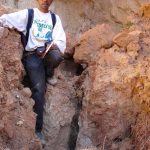
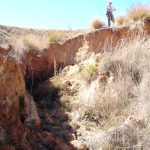
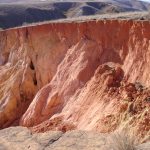
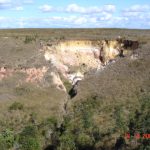
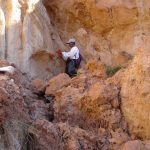
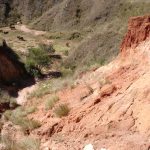
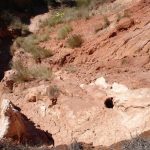
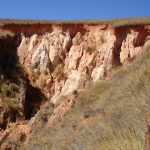
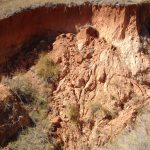
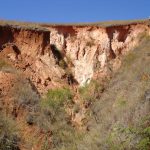
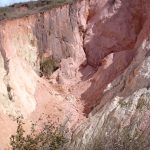
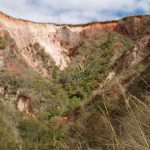
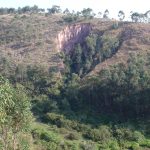
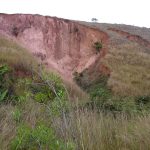
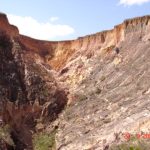
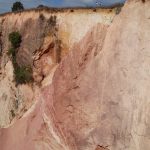
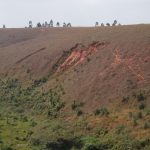
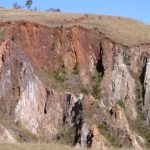
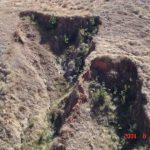
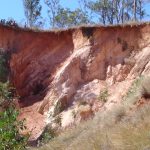
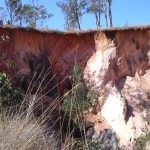
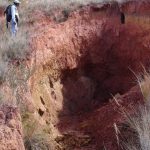
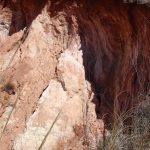
![Overhang at top of vertical head and side walls in stage II lobe]](https://sites.williams.edu/rcox/files/2022/11/lavaka_712-150x150.jpg)
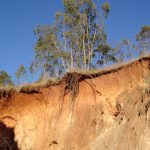
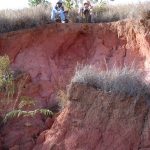
![Overhang at top of vertical head and side walls in stage II lobe]](https://sites.williams.edu/rcox/files/2022/11/lavaka_713-150x150.jpg)
